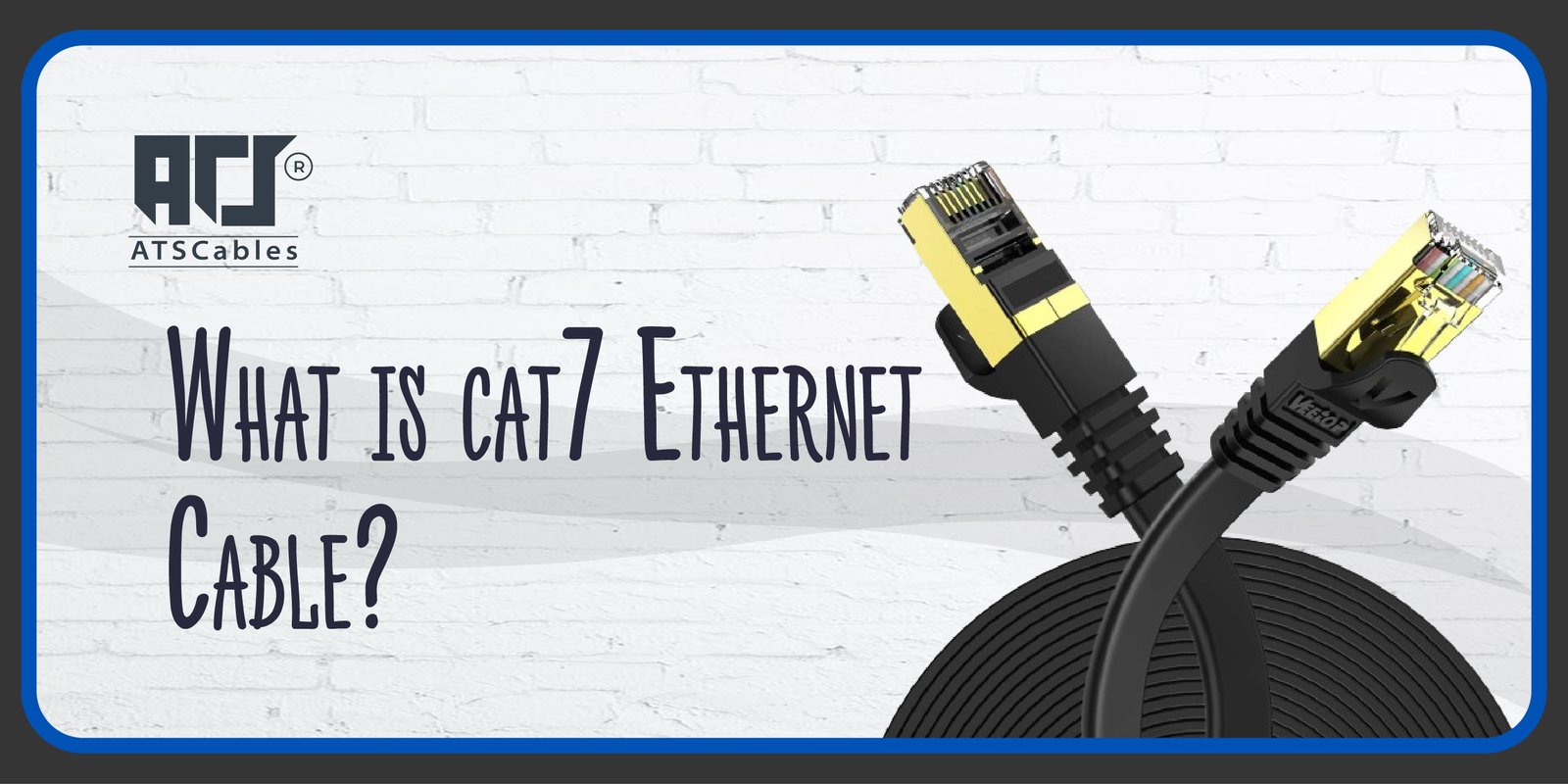
What Is Cat7 Ethernet Cable?
When it comes to high-speed internet and quicker data transfer, the ethernet cable cat7 is the optimal choice. It provides a much faster data transmission compared to other cat cables, such as cat5, cat6, etc. Cat7 supports 10 Gigabit Ethernet (10 Gbps) for the full 100 meters (328 feet).
As a result, it can provide high-speed data transfer even over longer runs. Unlike previous cat cables, cat7 features both individual shielding around each twisted wire pair and an additional overall shield for the entire cable.
This double protection significantly reduces external noise and interference, like radio and electromagnetic waves (EMI/RFI) that can disrupt data transmission. Let’s learn more about the use cases of the cat7 cable, its differences from the cat6 cable, and the optimal speed you can get from it.
Features and Specifications of 50-Foot Ethernet Cable Cat7
Cat7 cable is a high-performance cable designed for demanding network applications. While not an official standard, it boasts several features aimed at achieving superior speed, distance, and signal integrity compared to earlier Cat5e and Cat6 cables. Here’s a breakdown of its key characteristics:
- Speed – Cat7 is designed to support 10 Gigabit Ethernet (10 Gbps) speeds over the full 100 meters (328 feet) of cable length.
- Double Shielding – Unlike Cat6a which offers various shielding options, Cat7 requires full shielding (F/UTP). This double shielding significantly reduces external electromagnetic interference (EMI) and radio frequency interference (RFI) which can disrupt data transmission.
- Higher Frequency Potential – Cat7 is designed to handle frequencies up to 600 MHz, compared to Cat6a’s 500 MHz.
Cat7 offers promising features for future-proof networks requiring high speeds and minimal interference. However, the lack of official standardization and potential compatibility issues are important considerations.
Cat7 vs. Cat5 Ethernet Cable: What are The Key Differences?
Choosing the right ethernet cable can feel overwhelming with all the different Cat (Category) options available. Cat5 and Cat7 cables represent two ends of the spectrum. Here is a quick comparison between both of them to give you a better idea about it.
| Feature | Cat7 (Unofficial Standard) | Cat5 Ethernet |
| Speed | Up to 10 Gbps (potentially 40 Gbps at shorter distances) | Up to 100 Mbps |
| Frequency | Up to 600 MHz (theoretical) | Up to 100 MHz |
| Maximum Distance | 100 meters (328 feet) for unspecified speeds | 100 meters (328 feet) for 10 Mbps (performance degrades with distance) |
| Backward Compatibility | No official standard exists | Yes (limited to 10 Mbps with Cat5) |
| Shielding | Requires full shielding (F/UTP) | Unshielded (UTP) |
| Standardization | Not officially recognized by any major standards body | Established standard (ISO/IEC 10BASE-T) |
| Cost | More expensive | Less expensive |
Cat5 is a sufficient option for basic internet browsing and email. However, it is becoming outdated for modern network demands due to its limited speed. Cat7’s higher speeds and longer potential reach for future applications come at the cost of a non-standardized design and potentially higher cost.
Cat7 vs. Cat6 Ethernet Cable: What are The Key Differences?
While cat5 is an older version, cat6 shares some similarities with the cat7 cable. However, there are some key differences that you need to keep in mind to choose the right one for your needs.
| Feature | Cat6a | Cat7 (unofficial standard) |
| Speed | Up to 10 Gbps | Up to 10 Gbps (potentially 40 Gbps over shorter distances) |
| Frequency | 500 MHz | Up to 600 MHz (theoretical) |
| Maximum Distance | 100 meters (328 feet) for 10 Gbps | 100 meters (328 feet) for unspecified speeds |
| Backward Compatibility | Yes (with Cat5e & Cat6) | No official standard exists |
| Shielding | UTP, FTP, STP, SFTP | Requires full shielding (F/UTP) |
| Standardization | Officially recognized by ISO | Not officially recognized by any major standards body |
An important thing to note is that Cat7 is not a widely adopted standard and lacks official backing from major organizations like ISO. On the other hand, Cat6a offers sufficient performance for most modern network needs. It is best to choose Cat7 only if you specifically require the potential for future 40 Gbps speeds and are comfortable with a non-standardized cable.
Use Cases of 50-Foot Ethernet Cable Cat7
Cat7 cable is a high-performance option for building the core infrastructure of wired Gigabit Ethernet networks. It goes beyond typical Ethernet cables by offering several advantages:
Network Connectivity
Cat7 cables, also known as Cat7 LAN cables, are the workhorses of network connections. They efficiently link modems, hubs, and individual computers in all types of networks, from small home setups to large enterprises.
Industrial Strength
Built to endure challenging environments, Cat7 cables can withstand a variety of hazards. This makes them ideal for commercial and industrial applications where they might encounter:
- Extremes temperature
- Exposure to UV rays and moisture
- Direct contact with chemicals and oils
Home Networking
Cat7’s capabilities are attracting home users as well. They’re increasingly popular for domestic LAN cable networks. This is due to their potential performance boost for demanding applications like enthusiast gaming setups.
Final Words
In a world where the demand for high-speed data transfer is increasing, cat7 cables offer the most optimal solutions. So, if you’re looking to get your hands on one, then ATS Cables is here to help you find the right length of network cables according to your needs.
FAQs
Q1 Is Cat7 faster than Cat6?
Yes, Cat7 offers speeds up to 10 Gbps, while Cat6 is limited to 10 Gbps under ideal conditions (often reaching speeds closer to 1 Gbps).
Q2. What do UTP, SFTP, FTP, STP, and SSTP mean for Cat7 cables?
Here are the different options for cat7 cables available:
- UTP: Unshielded Twisted Pair (most common, affordable).
- SFTP: Shielded Foiled Twisted Pair (double protection with foil and mesh).
- FTP: Foiled Twisted Pair (foil shielding around each pair).
- STP: Shielded Twisted Pair (mesh shielding for all pairs).
- SSTP (not common): Double-shielded twisted pair (rare variation).
Q3.Is an unshielded Cat7 cable better than a shielded Cat7 cable?
Unshielded Cat7 isn’t recommended. Shielding helps prevent interference for reliable data transmission.
Q4 Can the Cat7 cable be spliced?
Splicing the Cat7 cable can damage the wires and degrade performance. It can be a challenge to splice the cable and ensure that it continues to retain the same performance. Use proper connectors for termination.
keep connected
Get updates by subscribe our weekly newsletter

